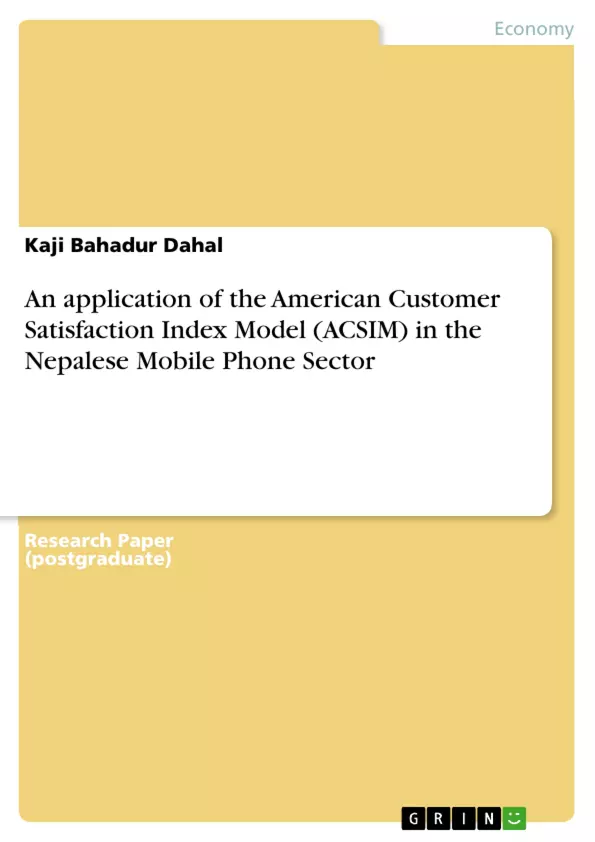Nepalese mobile phone market is one of the fast growing businesses with the penetration rate of at least 67.92% for GSM mobile services. Mobile phone providers have also been competing to offer dynamic services to customers. By doing this research, it is expected to offer inputs to enhance customer satisfaction with mobile services in Nepal.
The term ‘customer satisfaction’ has become an emerging issue for academic research as business organizations recognize that customer satisfaction is the only way to win in the given tough competitive business world. The aim of this paper is to measure the antecedents and consequences of overall customer satisfaction with mobile services in Nepal.
This study is probably the first of its kind in Nepal, which uses standard customer satisfaction measures (American customer satisfaction index model, (ACSIM) to examine the customer satisfaction with mobile services. It uses a structured questionnaire to collect the data from 242 young mobile users from two colleges in Nepal. Based on the observation, it is found that the influencing antecedents of customer satisfaction are customer expectation, perceived quality and perceived value. Similarly, it is also found that highly satisfied customers are more likely to repurchase and higher price tolerance to price increases by current mobile services provider or price decreases by rival. The result of this study is more applicable to young adult mobile services market in Nepal rather than to entire mobile subscriber population.
The study reveals that mobile services provider must focus on improving mobile services quality to increase customer satisfaction and customer loyalty. The value of this study is that it uses well known research model to measure customer satisfaction with mobile services in Nepal.
Inhaltsverzeichnis (Table of Contents)
- ABSTRACT
- Introduction
- 1. Theoretical Framework
- 1.1. American Customer Satisfaction Index Model
- 1.2 Antecedents of Customer Satisfaction
- 1.3. Consequences of Customer Satisfaction
- 1.4. Research Questions
- 2. Research Methodology
- 2.1. Data Analysis and Results
- 2.2. Outer or Measurement Model Evaluation
- 2.3. Goodness-of-fit indexes
- 2.4. Inner Model Specification
- 2.5. Discussion and Conclusions
- 2.6. Limitations and Directions for Future Research
- References
- APPENDIX
Zielsetzung und Themenschwerpunkte (Objectives and Key Themes)
This study aims to measure the antecedents and consequences of overall customer satisfaction with mobile services in Nepal, using the American Customer Satisfaction Index Model (ACSIM). This research is the first of its kind in Nepal to utilize the ACSIM model for this purpose.
- Customer satisfaction in the Nepalese mobile phone sector
- Antecedents of customer satisfaction, including customer expectation, perceived quality, and perceived value
- Consequences of customer satisfaction, such as repurchase likelihood and price tolerance
- Application of the ACSIM model in the Nepalese context
- Customer orientation in the mobile services industry
Zusammenfassung der Kapitel (Chapter Summaries)
- Introduction: The chapter highlights the importance of customer satisfaction in today's competitive business world. It introduces the context of the mobile phone market in Nepal and the increasing penetration rate of GSM services. The chapter also mentions the challenge for mobile services providers to focus on customer retention and the need for customer orientation.
- 1. Theoretical Framework: This chapter discusses the American Customer Satisfaction Index Model (ACSIM) as a widely adopted model for measuring customer satisfaction. It explains the features and advantages of ACSIM, emphasizing its use in previous studies on mobile services in other countries. The chapter outlines the antecedents (customer expectation, perceived quality, perceived value) and consequences (repurchase likelihood, price tolerance) of customer satisfaction within the ACSIM framework.
Schlüsselwörter (Keywords)
The key focus areas of this study are customer satisfaction, mobile services, Nepal, the American Customer Satisfaction Index (ACSI) model, and customer orientation. The research utilizes the ACSIM model to measure customer satisfaction with GSM mobile services in Nepal, focusing on understanding the influencing factors and outcomes of customer satisfaction.
- Citation du texte
- Kaji Bahadur Dahal (Auteur), 2014, An application of the American Customer Satisfaction Index Model (ACSIM) in the Nepalese Mobile Phone Sector, Munich, GRIN Verlag, https://www.grin.com/document/317801



